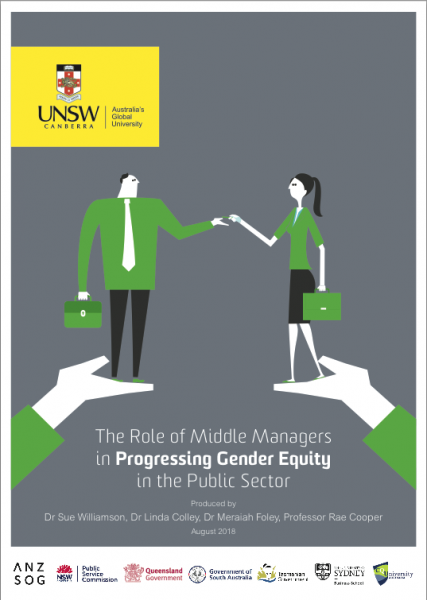Australia’s public sectors are implementing gender equity strategies, managers are committed to implementing these strategies, and many employees are supportive of them. Yet, we still hear that gender equity has been achieved, even from those in organisations where we know there is more to do. So, what’s going on?
As detailed in our new report, my colleagues and I have spoken with 300 middle managers in four public state service jurisdictions over the past year. We found a high level of commitment to progressing workplace gender equity. We also found, however, that managers largely considered that gender equity had been achieved once senior leadership positions consisted of 50 per cent of women.

Consequently, many managers considered that gender equity was not a high priority for their agency. We heard comments such as ‘gender wasn’t an issue’ in their organisation, and some wondered why we were still talking about gender equity at all.
Achieving gender parity in leadership cohorts is laudable, and a major achievement. It is, however, not the end of the story.
Even where gender parity is present, gender inequalities may still exist
Even where gender parity is present, gender inequalities may still exist. Existing human resource processes and practices, cultural norms, workplace behaviours, and everyday work practices can reinforce occupational segregation and limit women’s career pathways; pockets of ‘blokey’ behaviour may still exist and a long-hours culture, inimical to those with caring responsibilities may prevail.
How can workplace practices and cultures adapt to counter ‘gender fatigue’? Our research shows that while gender equality strategies are enabling conversations about the topic, many managers still do not know how to raise these issues. Some managers included gender equality on the agenda of the regular team meetings, while others engaged in ‘water cooler’ conversations about equity.

Human resource departments have an important role to play is assisting managers with these conversations. The managers we spoke with requested that HR provide topics they could discuss. So, for example, managers could talk about how the whole team can enable team members to work flexibly; or how work is allocated to ensure that both male and female employees undertake both the ‘glamour’ jobs, as well as the ‘office housework’.
Many managers told us that they didn’t know what the ‘burning platform’ for gender equity was in their organisation
As well as this important initiative, gender fatigue can be overcome by utilising a change management process. This means firstly, that a sense of urgency about the required changes needs to be instilled in managers and staff. Many managers told us that they didn’t know what the ‘burning platform’ for gender equity was in their organisation. Senior managers need to articulate the reasons why it is imperative to continue to progress gender equity.
Secondly, wins need to be celebrated. This includes acknowledging big achievements, such as securing White Ribbon accreditation, as well as smaller ones, such as success stories about working flexibly.
Thirdly, innovative workplace practices are important. Organisations that are successfully progressing gender equity are trying new things, such as ‘all roles flex’ and creating positions according to the work needing to be done, rather than assuming all positions are full-time. More leading practices can be found in our new guide for middle managers.
Importantly, however, the impact and outcomes of these innovations require evaluation, so that employees and organisations know exactly what works.
The public sector has been committed to achieving gender equity for the past 40 years or so. While much-needed strategies and practical initiatives continue to be necessary, overcoming gender fatigue will ensure that organisations move from parity, to equity.
Researchers also included Dr Linda Colley, CQUniversity, Dr Meraiah Foley, UNSW Canberra and Professor Rae Cooper, University of Sydney. Research partners were the New South Wales, Queensland, South Australian and Tasmanian governments. The main funder of the project was the Australia and New Zealand School of Government.





